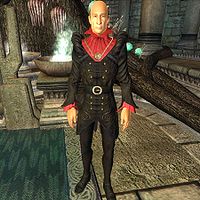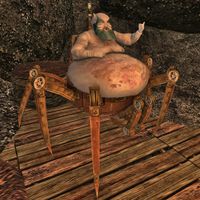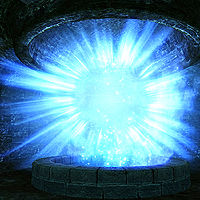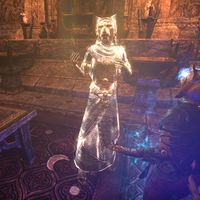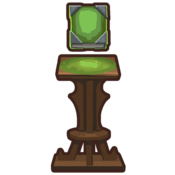Lore:Lifespan
This article documents the lifespans of the various races of Nirn, as well as the various methods of life-extension and resurrection.
Racial Lifespans[edit]

Beastfolk[edit]
Beastfolk tend to live a maximum of one hundred years.[1] Sload do not conform to this standard, as no natural limit to their lifespan has ever been observed or recorded. The eldest among them must remain buoyed by water, lest they collapse under their own immense weight.[2] Centaurs have been known to call other races 'mortals', implying they have an extended lifespan.[3] The lifespan of Khajiit varies by furstock, with the Senche-raht being the longest-lived.[4]
Men[edit]
Men tend to live a maximum of one hundred years.[1] Half-Elven men, despite their parentage, age as any other men do.[5] An exceptional case of unnatural human longevity has been recorded with Sirollus Saccus,[6][7] though the underlying cause remains uncertain, with magical influence being the most likely explanation.
According to Nordic myth, Orkey is responsible for the shortened lifespan of men, as they once had the same long-lives as elves. However, Orkey's machinations led to him instructing Alduin to eat the Nords' lifespans down to just six years. This was undone by Shor and Wulfharth, but in Wulfharth's haste to save everyone, he accidentally aged himself to death. Most of this curse was then supposedly thrown on to the Orcs.[8][9] Prior to their migration to Hammerfell, some Yokudans have been documented living long lives, such as commoner-turned-Elden Yokeda Randic Torn, who reigned the Yokudan Empire for 120 years.[10]
Mer[edit]
Mer tend to live for several centuries up to a thousand years, though few ever reach this upper limit due to external factors.[11][UOL 1][12] In this regard, among the Altmer, being well over a century old is considered young.[13] It is said that Phynaster, the hero-god of the Summerset Isles, taught the Altmer how to extend their natural lifespans by an additional one hundred years through the practice of shortening their stride.[14] Some of the most ancient and powerful Elven mages are also known to have extended their lives. Notable examples include Barenziah and Symmachus of Mournhold, as well as individuals who have endured for millennia through advanced magical practices, such as Divayth Fyr and Ritemaster Iachesis of the Psijic Order.[15][16]
The Orsimer are a notable exception among the mer, as they generally live significantly shorter lives.[17] According to Nordic tradition, this condition is the result of Orkey's defeat at the hands of Shor,[9] though the Orsimer themselves believe it to be a punishment imposed by Malacath.[18]
Akaviri[edit]
Although literature often attributes immortality to the Tsaesci,[19][20] descendants of Tsaesci refugees in Elsweyr claim that longevity is not a trait of the race and speculate that the lengthy longevity of figures such as the Potentates had magical origins.[21][22] Survivors of the Second Akaviri Invasion from the Kamal race reportedly lived in hiding for over two hundred years.[23][24]
Methods of Life Extension[edit]
Alchemy[edit]
Gyron Vardengroet, in an effort to prevent others from experiencing the same grief he went through after his parents' deaths, set out to make a potion that achieved biological immortality. After poring over research from the Crystal Tower and gathering flora from all over Tamriel, he eventually succeeded in halting his aging with a potion he had brewed. However, he was unsure which of the many combinations he mixed resulted in the successful tonic.[25] The Gray Host brewed potions which could temporarily transform the drinker into Werewolf Behemoths,[26] which are noted immortals.[27][28] Brazzefk, a Dwemer alchemist, created and consumed a potion intended to make him into an immortal stone golem, but it instead turned him into an immovable stone.[29] The honey of the Isgareth Bee of Auridon allegedly halted aging upon consumption, but would wear off and need repeated consumption in order to maintain the effect.[30] The consumption of Gildergreen fruits was thought to extend one's lifespan.[31]
Apotheosis[edit]
Ascension to the status of godhood is one of the hardest and most mysterious methods of achieving immortality. The Tribunal infamously ascended using Kagrenac's Tools on the Heart of Lorkhan, utilizing the Heart's innate divine energy. Dagoth Ur formed a connection to the Heart without the tools through unknown means, likewise becoming a god.[32] During the Fourth Era, the rogue Clockwork Apostle Mecinar used his reconstructed body to obtain divine power from the Mechanical Heart in order to become a god. The Forgotten Hero might've also tapped into the Mechanical Heart via Sotha Sil's replicas of Kagrenac's Tools, in order to briefly achieve a form of godhood and stop Mecinar.[33][34]
Several mortals underwent a process known as mantling[35][36] during the Greymarches of the Shivering Isles, becoming Sheogorath[35][37] until the following Greymarch, when they were replaced by another and made into immortal Vestiges of their mortal selves.[36]
In 2E 582, the Altmer Aranias took up the crown of the Wilderking, taking his place and becoming the Wilderqueen.[38]
According to legend, Sai was made a god by Reymon Ebonarm to assist in balancing the forces of mortals with his innate lucky presence.[39] Similar legends involve Xarxes being raised to godhood by Auri-El and Arkay being raised to godhood by Mara.[40][41]
The Numidium could be used to transcend Mundus and become a god.[42]
The Duraki spawning pools of Skyreach were theorized to harness the energy of Nirncrux and use it to elevate mortal creatures and people to godly celestial manifestations of the constellations.[43] Jode's Core, if properly channeled through aeonstone, was thought to be capable of granting godhood.[44][45][46] Tosh Raka of Ka Po' Tun was said to have become a Dragon.[19]
During the Warp in the West in 3E 417,[47] Mannimarco used the power of the Mantella to fuel his transfiguration and apotheosis, creating the Necromancer's Moon.[42] In an alternate timeline, that world's Mannimarco succeeded in his scheme of becoming a Daedric Prince during the Planemeld, by using the Amulet of Kings to imprison Molag Bal within the gem and take his place as a god, and came to rule over the merged worlds.[48][49]
According to some sources, when Martin Septim shattered the Amulet of Kings and transformed into the Avatar of Akatosh at the end of the Oblivion Crisis, the event resulted in him Mantling Akatosh, and thus achieving Apotheosis.[UOL 2][UOL 3]
During the Umbriel Crisis, Hierem schemed to use the power of the White-Gold Tower to siphon the thousands of souls within Umbriel's Ingenium, an act which he believed would turn him into a god, but he was killed before he could make the attempt.[50]
Some dubious sources claim that Tiber Septim achieved apotheosis by absorbing the essences of several dragons.[51]
Body Alteration[edit]
Diseases of divine origin occasionally bestow immortality. Vampires are immortal, courtesy of their undead nature.[52][53] The Divine Disease, Corprus, renders those afflicted immune to disease and aging, alongside other debilitating side-effects.[54] The mechanical bodies of the Clockwork Apostles grant unending life if their internal organs are replaced. Those who do have no need for eating, breathing, or sleeping.[55][56] Briarheart implantations may be used to raise the dead.[57] Heart Stones function similarly to Briarhearts, but prevent the bearer from dying altogether, keeping them between life and death.[58][59][60]
Witches who transform themselves into hagravens seem to experience an extended lifespan,[61][62] as do hags.[63][64] Some witches were known to extend their lifespans without the need for transformation.[63] At least some have achieved this through Daedric pacts,[65] but it is not known whether this is the only method used.[63] Maormer rituals could turn the caster into a being of water and coral,[66] which could supposedly reform after death.[67][68] Worm Cult necromancers resurrected Emperor Leovic by transforming him into a Flesh Atronach.[69] Bosmer who undergo the irreversible Wild Hunt live forever, at the cost of their sanity.[70]
Divine Intervention[edit]
Rarely, gods will bestow unending life if it is requested of them or to those they deem fit. In ancient times, Wilderking would open his realm, the Shrouded Vale, to Nirn every century to recruit a new caretaker for the Fading Tree. The Wilderking would provide for the caretaker, granting them long life and sustenance.[71] After connecting with the Heart of Lorkhan, Dagoth Ur shared his divine essence with his followers,[72] granting them eternal life.[73] Gavos, a priest of Zenithar, saw his life extended by a miracle from the god for his hard work and toil to keep the Golden Anvil safe.[74][75] During the Interregnum, ancient scroll that magically appeared within the Imperial City granted eight priests of the Divines immortality, returning to their mortal form after death.[76] It was thought that Arkay was behind the scroll's magic.[77] It has been theorized that rarely, in times of crisis, the Aedra may revive individuals of importance to assist Mundus.[78] Through the Heart of Valenwood, the Green may resurrect individuals to serve as Silvenar.[79]
Daedric Princes are able to bestow longevity[65] and immortality in a variety of ways. Reachmen folk tales of Tancia tell of her entering into a bargain with a Prince, causing her to lose her sanity and become an immortal scourge.[80] Hircine has granted immortality to those who set out to hunt his finest beasts, returning their aging after their beast has been felled.[81] The first turned, the original beings who were first afflicted with Lycanthropy by Hircine in the Early Merethic Era,[82][83] were immortal.[84] Meridia's Purified were given immortality in exchange for subservience, willing or otherwise.[85][86] Mehrunes Dagon once entered into a pact which granted Chimere Graegyn immortality, but kept his aging, eventually leaving him crippled with arthritis.[87] Princes can bless a mortal with a Daedric form, seemingly fit with all of the form's abilities, but may take it away later.[88] Some Daedric Artifacts grant eternal life, such as the Ring of Hircine.[89]
Cernunnon was known to grant immortality to their champions. As long as the spirit remained undefeated, their oath-bound enjoyed effective immortality, as it was Cernunnon who had the authority to determine their deaths.[90][91][92] According to Nordic legend, Shor resurrected Wulfharth from his ashes.[8] Wulfharth then became a being of ash, capable of sustaining a solid form with rest. When grievously struck, rather than dying, he was merely reduced to a formless ash state.[93] Molag Bal was able to return a follower of Boethiah to life when in close proximity of his shrine.[94] The Daedric Prince Azura has been known to sometimes resurrect spirits whose regrets prevented them from entering the afterlife even though they'd been accepted.[95][96]
Spellcraft[edit]
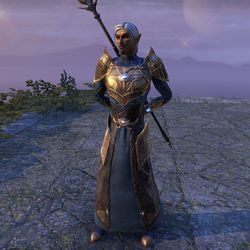
Spells applied directly to the body have been known to extend life.[97] The Psijics were renowned for practicing life extension magic.[18] Talented mages were capable of significantly prolonging their lifespans.[45][98] Divayth Fyr lived for over four thousand years using magic,[99] but did not consider himself an immortal.[100] Arch-Mage Shalidor is said to have lived for many lifetimes and to have known the secret of "life everlasting", a secret he could share with others to also extend their life, as he wished to do with his wife, Ulfsild, who ultimately rejected immortality.[101] Imperial Battlemage Jagar Tharn claimed to possess the ability to grant others everlasting life, using the prospect both as a potential reward for those who'd serve him and as a potential punishment for his foes, whose suffering he claimed would span millennia.[102] Void magic can transform individuals into immortal voidmothers through soul collection and offerings to the Void.[103][104] Powerful arcane experiments that go wrong can destroy the user's corporeal form, fusing them to the magical energies surrounding them. These individuals may manifest as a maelstrom of magicka.[105]:172 Grimkell, an Atmoran sorcerer of the Merethic Era, turned three of his former allies into stones in an ambush. The fourth target, Ulfgar, was accidentally turned into a 'living stone', allowing him to live for over four thousand years.[106] During the Dragon rule over Skyrim, Dragon Priests were granted a share of Dragon magic to become immortals. As the Dragon magic faded, the Draugr of the Priests' tombs would perform rituals on their sarcophagi to sustain their life.[107][108][109] To achieve a heightened state of lichdom, Hevnoraak planned to transfer his blood back into his body, reawakening him at the peak of his power.[110] It is said that siphoning a soul's essence can prolong one's life.[111]
Resurrection has been accomplished with spells while maintaining the recipient's intelligence. Rare scrolls have been known to rejuvenate and resurrect fallen individuals moments after their death.[112] Although some have thought it impossible to completely resurrect a dead person whose soul belonged to a Daedric Prince,[113] Angof the Gravesinger managed to revive Faolchu, a Werewolf, centuries after his death.[114] An obscure arcane discipline known as life magic was used by the Gray Host in order to resurrect vampires and werewolves.[115] The souls of the fallen Host members were drawn into stone husks, inanimate vessels alchemically designed to house their life energy.[116][117] In a final ritual, the stone husks shattered and the mortal forms of the long-dead members were restored.[118]
Necromancy may be used to turn one's self into a Draugr, halting their aging infinitely.[119] During the Thrassian Plague, Corgrad was decimated by the disease. The lords of Corgrad performed sorcery to contain the disease which drained its ravaging effects into themselves. Those who were cured and their descendants gave their tainted blood to the lords, keeping them alive for millennia.[120][121] Circa 2E 582, in a bid to cure their decrepit condition once and for all, the lords kidnapped a fellow Altmer of untainted blood and prepared sorcery to turn him into one of their condition, making him immortal until later generations of pure blood could restore him.[120] Certain binding rituals prevent the aging of the prisoner, rendering them unaging and invulnerable.[17] Daedra may be bound in a blood sacrifice, allowing the binder to live as long as they remain bound.[30] Perena soul magic could grant immortality at the sacrifice of becoming an eternal watcher.[122][123] A similar ritual could be performed at the Dragonfire Cathedral, making the caster immortal at the cost of binding them to the Cathedral's premises.[76]
Spirit Transference[edit]
Transferring the soul out of a mortal body and into an object or unaging living vessel prevents aging, but can cause drastic changes in behavior.[124] Transference has occasionally been used as a curse, binding an unwilling subject to an unmoving object.[125] The most advanced form of transference is lichdom, a process in which necromancers place their soul within - and travel through - a physical object known as a phylactery.[126] If the advanced process is successful, the lich will survive in spirit form after being killed and can eventually reform its body.[127] After becoming a lich, the lich's physical body is left aged and withered. However, this can be circumvented with Illusion magic.[128]
Mortals who are soul-trapped before their death by worshippers of Molag Bal become Soul Shriven, reforming a replica of their body in Coldharbour. This replica is typically flawed due to the strong Padomaic influences of Oblivion.[129] If they die, their bodies reform, eventually turning them into mindless, feral beasts.[130] Those who lost their mind before becoming Soul Shriven are seemingly immune to the degrading effects.[131] Individuals with a unique Anuic aspect can reform their body perfectly, retaining their full abilities and intelligence.[129]
Unlike the Vestiges of Daedra, the souls of mortals are described as not fettered to existence, with the proper rites they can be "decoupled" from the body entirely and persist as immortal spirits that sustain themselves by consuming other souls. This unmooring process is not the same as the soul being separated from the body at death because then the resulting spirit is dead, a Ghost, whereas if separated prior to death the mortal becomes a living spirit.[132] The mutability of a mortal soul is said to extend to its vessel, making it possible to change one's corporeal form through some basic magic, a change a number of mages have undergone in an effort to attain longer life or greater power, taking on forms such as that of a Voriplasm , a tree, a Tomeshell, a Giant, a Golem or Flesh Atronach, or even a Dragon skeleton.[133][134][135][136][137][138][139]
There have been cases where the spirit of a dead mortal has entered the body of a living being and integrated itself with the living soul residing there thus attaining a form of second life. The integration phenomenon results in the soul of the spirit merging with the soul of the living host without exerting control, thus the spirit is effectively reborn or reincarnated into the living host, who will than start to experience the memories of that spirit as if they'd lived through them, and manifesting the knowledge and abilities the soul reincarnated within them possessed and feeling its emotions as their own. The phenomenon has also been described as a spirit being resurrected as the "twin soul" of its host. The initial entry of the soul into the living body is accompanied by a brief bout of intense pain, after the rebirth, other spirits who knew the reincarnated soul in life can sense its presence within its reincarnated form and realize the host soul and the reincarnated soul as now being the same. Though such spiritual rebirth is possible, it is said that it is relatively rare for spirits to behave in that manner.[96][140][141][142]
Time Dilation[edit]
When in realms outside of Mundus, time passes differently than mortals are conditioned to. Planes, while affected by time, are not subject to it and its limitations[36] and may adopt degrees of it by the choice of its host.[143] Mortals in realms with little-to-no passage of time experience a prolonged existence,[144][145] perceiving time at a slower rate than those on Nirn.[146][145] Jagar Tharn imprisoned Uriel Septim VII in a dimension of his own creation where time flowed at a different rate than on Nirn, making so it would take centuries for the emperor to finally die.[148] Shalidor is said to have stolen Glamoril, the secret of life, from Akatosh.[149] The exact function of this artifact is unknown, but it was related to life extension.[97] One of the College of Winterhold's many theories as to its function was that it allowed the Arch-Mage to live multiple lifetimes in a short span of time.[150]
Other[edit]
Azra Nightwielder survived for centuries suspended within a crystal.[151] A magical relic known as the Great Source resided within the Aetherian Archive during the First Era. A group known as the Firstmages harnessed the Source's power, resulting in the extension of their life.[152] It is rumored that several pools and springs throughout Tamriel can grant immortality, but no maps exist which depict these locations.[30] Mankar Camoran's realm, Paradise, made his followers immortal. They would reform in the realm if they ever died, wherever their death took place.[153][154] These 'ascended immortals'[155] weren't considered true immortals, and were referred to distastefully as 'unmortals'.[156] Those whose souls go to Oblivion may escape their designated realm with their mortal form intact and capable of returning to Nirn.[157]
Some sources claim that mortal spirits experience a change upon reaching Aetherius, with many souls of mortals becoming spirits of a different sort in that place.[158] Many reports from across Tamriel describe a phenomenon where the souls of the dead adopt a variety of forms to return and speak with the living. Animals, plants, or even fearsome visions, are all reported manifestations. It is theorized that the Luminaries, immortal beings of pure magic, might have originated as mortal souls, being the spirits of Ascended Ancestors that transformed into their current state after death due to this described phenomenon. As the Luminaries themselves can't recall their origins, this theory remains unproven.[159][160] Whatever the case, however, a Luminary can indeed be created out of the essence of a mortal soul, as was the case with the Crow Luminary, who was created through a ritual devised by Ulfsild the Evergreen out of a portion of her own essence. Though the process is straining and the restoration of the spirit takes time, a soul that was used in such a manner will eventually recover.[161][162][163]
See Also[edit]
- For more information on the burial and funerary practices of Nirn, see Death.
Books[edit]
- Ascendancy: Pathway to Lichdom by Gullveig the Ascendant — A short guide detailing the steps required to become a lich
- On Extending Existence by Barilzar, Mage of the Seventh Order and Artificer Extraordinaire — A mage's musings on prolonging life
- On Immortality by Anonymous — Musings on immortality
References[edit]
- ^ a b Ask Us Anything: Variety Pack 4
- ^ Pocket Guide to the Empire, 1st Edition: The Wild Regions — Imperial Geographical Society, 2E 864
- ^ Elder Centaur's dialogue in Legends
- ^ All Our Perfect Forms — Amun-dro, the Silent Priest
- ^ Brief History of the Empire v 2 — Stronach k'Thojj III
- ^ The Armorer's Challenge — Mymophonus
- ^ Sirollus Saccus in Morrowind
- ^ a b Five Songs of King Wulfharth
- ^ a b Varieties of Faith: The Nords — Brother Mikhael Karkuxor of the Imperial College
- ^ Redguards, History and Heroes — Destri Melarg
- ^ Interview with a Dark Elf
- ^ The Real Barenziah, v 2 — Anonymous
- ^ Leramil the Wise's dialogue in ESO
- ^ Varieties of Faith: The High Elves — Brother Mikhael Karkuxor of the Imperial College
- ^ Fragment: On Artaeum — Taurce il-Anselma, 3E 400
- ^ Psijic Mascot Bear Cub pet description in ESO
- ^ a b Gurlak's dialogue in ESO
- ^ a b Ulliceta gra-Kogg's dialogue in ESO: Summerset
- ^ a b Mysterious Akavir
- ^ History of the Fighters Guild
- ^ Avita Pitio's dialogue in ESO: Elsweyr
- ^ Avita Pitio's dialogue from Elder Scrolls Online: Elsweyr
- ^ The Second Akaviri Invasion — Yngmaer Raven-Quill, Historian Royal of the Bards' College, Solitude
- ^ Pocket Guide to the Empire, 1st Edition: The Elsweyr Confederacy — Imperial Geographical Society, 2E 864
- ^ The Sage — Aegrothius Goth
- ^ Stone Garden Werewolf Behemoth transformation in ESO: Stonethorn
- ^ Exarch Ulfra's dialogue during The Gray Council in ESO
- ^ Werewolf Behemoth Sigil memento description in ESO: Wolfhunter
- ^ Head of Brazzefk — Merethic Society
- ^ a b c On Immortality — Anonymous
- ^ Ardwen's dialogue in Skyrim
- ^ Plan to Defeat Dagoth Ur — Vivec
- ^ Mecinar's' dialogue in the cutscene, 'Mecinar Triumphant', in Return to Clockwork City
- ^ Events of Return to Clockwork City
- ^ a b Jyggalag's dialogue in Oblivion: Shivering Isles
- ^ a b c Chamberlain Haskill Answers Your Questions — Chamberlain Haskill
- ^ Sheogorath's dialogue in Skyrim
- ^ Throne of the Wilderking quest in ESO
- ^ King Edward, Part IX — Anonymous
- ^ Tu'whacca, Arkay, Xarxes — Lady Cinnabar of Taneth
- ^ Ark'ay The God — Mymophonus the Scribe
- ^ a b Lives of the Emperors — Niso
- ^ Dawn of the Exalted Viper — The Exalted Viper
- ^ Kaalgrontiid's dialogue in ESO: Dragonhold
- ^ a b Abnur Tharn's dialogue in ESO
- ^ Cadwell the Betrayer's dialogue in ESO: Elsweyr
- ^ The Warp in the West — Ulvius Tero
- ^ Traitor's Vault Temporal Tome — Rullinalion
- ^ Tracker of Temporal Tomes achievement description in ESO
- ^ Lord of Souls — Greg Keyes
- ^ There Be Dragons — Torhal Bjorik
- ^ Daggerfall User's Guide
- ^ Generic dialogue regarding Vampires in Morrowind
- ^ Divayth Fyr's dialogue in Morrowind
- ^ Meet the Character - Proctor Luciana — Grimrald Brassbones
- ^ Appearance of Proctor Luciana Pullo in ESO: Clockwork City
- ^ The Care and Feeding of Briarhearts
- ^ Neloth's dialogue in Skyrim: Dragonborn
- ^ Ildari's Journal, vol. I — Ildari Sarothril
- ^ Ildari's Journal, vol. II — Ildari Sarothril
- ^ Appearance of Fallaise of Glenmoril Wyrd, Ettiene of Glenmoril Wyrd, and Isobel of Glenmoril Wyrd in Morrowind: Bloodmoon
- ^ Appearance of Fallaise, Ettiene, and Isobel in Skyrim: Dragonborn
- ^ a b c Rites Matron's dialogue in ESO: Markarth
- ^ Appearance of Lamenter of the Slain and Binder in the Dark in ESO: Markarth
- ^ a b To Posterity — Hafara
- ^ Appearance and abilities of Fleet Queen Taleria in ESO: High Isle
- ^ Tideborn Taleria's dialogue in ESO: High Isle
- ^ Admiral Galvendier's dialogue in ESO: High Isle
- ^ Emperor Leovic's dialogue in ESO
- ^ Pocket Guide to the Empire, 1st Edition: Aldmeri Dominion — Imperial Geographical Society, 2E 864
- ^ Henodras' dialogue in ESO
- ^ Dagoth Ur's dialogue in Morrowind
- ^ Vivec's dialogue in Morrowind
- ^ Daluion's dialogue in ESO: Blackwood
- ^ Arbitrator Gavos Douar's dialogue in ESO: Blackwood
- ^ a b Drake of Blades' dialogue in ESO: Imperial City
- ^ Arrianus Capius' dialogue in ESO: Imperial City
- ^ Ja'darri's dialogue in ESO: Dragonhold
- ^ Indaenir's dialogue in ESO
- ^ Scary Tales of the Druadach, Book 3 — Cassia Volcatia, Traveling Scribe
- ^ Haras' dialogue in ESO
- ^ A Cure for Lycanthropy — Archivist Ernarde of the Silver Dawn
- ^ Sage Svari Answers Your Questions — Sage Svari
- ^ Vykosa the Ascendant in ESO: Wolfhunter
- ^ Tharayya's dialogue in ESO: Wrathstone
- ^ King Narilmor's dialogue in ESO: Wrathstone
- ^ Tal Marog Ker's Researches — Tal Marog Ker
- ^ Aelif's dialogue, appearance, and abilities in ESO
- ^ Tharsten Heart-Fang's dialogue in Morrowind: Bloodmoon
- ^ Mochveda, Tuecille, and Erbogar's dialogue in ESO: Horns of the Reach
- ^ Cernunnon's dialogue in ESO: Horns of the Reach
- ^ Oathbreaker's achievement description in ESO: Horns of the Reach
- ^ The Arcturian Heresy — The Underking, Ysmir Kingmaker
- ^ Events of The House of Horrors in Skyrim
- ^ Krin'ze's Journal — Cantor Krin'ze
- ^ a b Zerith-var's dialogue in ESO
- ^ a b Arch-Mage Shalidor's dialogue in ESO
- ^ Savos Aren's dialogue in Skyrim
- ^ Alfe Fyr's dialogue in Morrowind
- ^ Divayth Fyr's dialogue during Vivec in Legends
- ^ Our Story — Ulfsild
- ^ Jagar Tharn's dialogue in Arena
- ^ Senan's Note — Senan
- ^ Nathari's dialogue in ESO: Markarth
- ^ The Elder Scrolls V: Skyrim: Prima Official Game Guide — David Hodgson
- ^ Ulfgar the Unending's dialogue in Morrowind: Bloodmoon
- ^ Kireth's Taarengrav Note — Kireth Vanos
- ^ Draugr and the Dragon Cult — Dragon Cult Chronicler, Skormvnir Kyrrund
- ^ Amongst the Draugr — Bernadette Bantien, College of Winterhold
- ^ Valdar's dialogue in Skyrim
- ^ Siluran's Journal — Siluran
- ^ Appearance and abilities of Scroll of Revivial in Blades
- ^ A Daedric Proposal — Galdrus Salobar, Sanguimancer Supreme
- ^ Vision of Angof's dialogue in ESO
- ^ Gwendis' dialogue in ESO
- ^ Exarch Tzinghalis' dialogue in ESO: Greymoor
- ^ Arkasis the Mad Alchemist's dialogue in ESO: Stonethorn
- ^ Sister Tharda's dialogue in ESO: Greymoor
- ^ Draugr Lord Aesliip's dialogue in Morrowind: Bloodmoon
- ^ a b Kinlord Nemfarion's dialogue in ESO: Summerset
- ^ Arillas' dialogue in ESO: Summerset
- ^ Watcher Shavmar's Journal — Watcher Shavmar
- ^ Watcher's Ritual Stole antiquity codex entry by Verita Numida in ESO: Greymoor
- ^ Terari Heladren's dialogue in ESO: Clockwork City
- ^ Broken Statue's dialogue in ESO
- ^ Ascendancy: Pathway to Lichdom — Gullveig the Ascendant
- ^ Mannimarco's dialogue in ESO
- ^ Vastarie's dialogue in ESO
- ^ a b Chaotic Creatia: The Azure Plasm — Doctor Rhythandius
- ^ Cadwell's dialogue in ESO
- ^ Lyris Titanborn's dialogue in ESO
- ^ Uldazaan the Heresy-Keeper's dialogue in ESO
- ^ Sorcerer Rectavius in ESO
- ^ Vorm in ESO
- ^ Orryn the Black in ESO
- ^ Thallik Wormfather in ESO
- ^ Strange Sapling in ESO
- ^ Reynelle Derone's role during Mind of Madness in ESO
- ^ Dialogue during Atronach Hunting quest in Daggerfall
- ^ Cantor Krin'ze's dialogue in ESO
- ^ Viti's Notes: Order of the Hidden Moon, Part I — High Cantor Viti
- ^ Krin'ze's Journal — Cantor Krin'ze
- ^ Lord Fa-Nuit-Hen and Tutor Riparius Answer Your Questions 2 — Fa-Nuit-Hen and Tutor Riparius
- ^ "Death" of Morphotypical Entities — Doctor Rhythandius
- ^ a b Chaotic Creatia: The Azure Plasm — Doctor Rhythandius
- ^ Faven Indoril's dialogue in ESO: The Deadlands
- ^ Cite Book
- ^ Brief History of the Empire v 4 — Stronach k'Thojj III[147]
- ^ A Minor Maze
- ^ Urag gro-Shub's dialogue in Skyrim
- ^ Azra Nightwielder's dialogue in Shadowkey
- ^ Firstmage Arnure's dialogue in ESO
- ^ Ruma Camoran's dialogue in Oblivion
- ^ Eldamil's dialogue in Oblivion
- ^ Ascended Immortals in Oblivion
- ^ Kathutet's dialogue in Oblivion
- ^ Lyris Titanborn's dialogue in ESO: Harrowstorm
- ^ Girnalin's dialogue in ESO
- ^ Loremaster's Archive - Scribing — Votary Nahila
- ^ Ulfsild's Notes: The Origin of Luminaries — Ulfsild
- ^ The Crow's dialogue in ESO
- ^ Ulfsild the Evergreen's dialogue in ESO
- ^ Fable of the Crow
Note: The following references are considered to be unofficial sources. They are included to round off this article and may not be authoritative or conclusive.
- ^ Ask Us Anything: Variety Pack 4
- ^ Michael Kirkbride's Posts
- ^ Kurt Kuhlmann's comments on Decrypting The Elder Scrolls — Game Informer article

